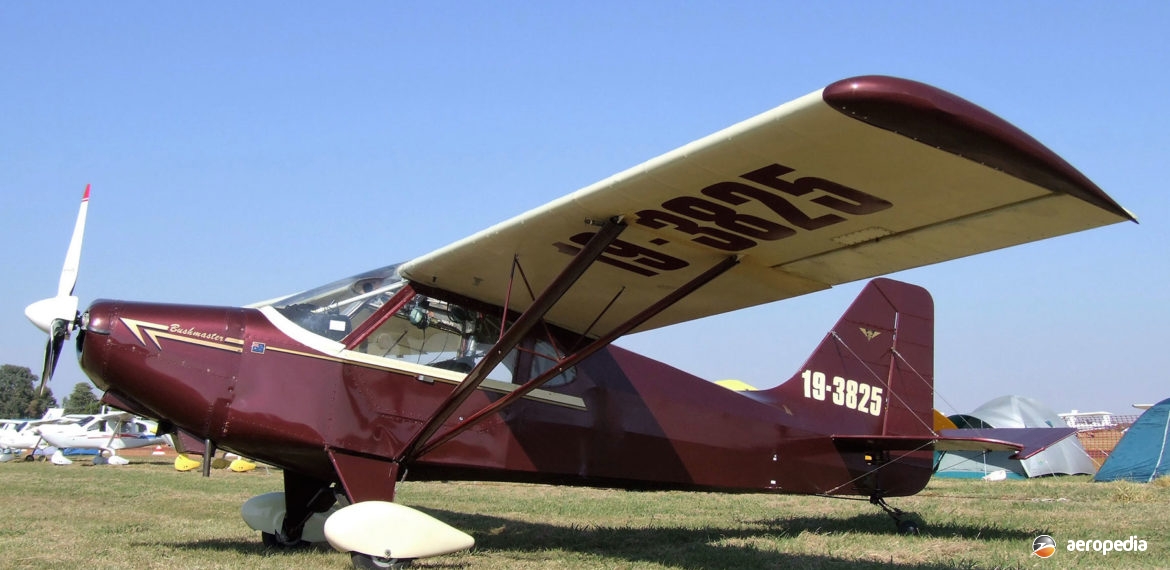Photograph:
Aircorp BN-2 Bushmaster prototype 19-3825 (c/n 89-001) at Watts Bridge, QLD (David C Eyre)
Country of origin:
Australia
Description:
Two-seat light touring and training aircraft
Power Plant:
One 67 kw (90 hp) Norton Aerotor twin-chamber rotary engine; or
(Proposed production aircraft) One 87 kw (116 hp) Lycoming O-235-N2C four-cylinder horizontally-opposed air-cooled engine
Specifications:
- Wingspan: 10 m (30 ft 9 ¼ in)
- Length: 6.40 (21 ft)
- Wing area: 10 m² (150.7 sq ft)
- Max cruising speed: 185 km/h (115 mph)
- Stalling speed: 65 km/h (40 mph)
- Fuel capacity: 100 litres (22 Imp gals)
- Empty weight: 410 kg (904 lb)
- Loaded weight: 700 kg (1,543 lb)
History:
An Australian entry into the manufacture of light aircraft, the prototype Bushmaster VH-BOI (c/n 89-001) flew for the first time in Queensland on 28 October 1989. Designed as a light aerobatic and touring aircraft to US FAR-23 Regulations for service with aero clubs and training organisations, it could also be used as a private touring aircraft.
Fitted with a tailwheel type undercarriage, construction was of conventional welded steel tube with fabric covering aft of the cabin, and an all-metal wing. Designed by Mr C W Whitney, the prototype was fitted with a 67 kw (90 hp) Norton Aerotor rotary engine but there was some delay in certification of this engine, and, following the first flight, it was fitted with the Lycoming O-235 engine. The prototype VH-BOI did not have flaps but production aircraft were planned to have three-stage flaps, all-metal skin in place of the fabric, and 53.3 cm (21 in) greater length.
A number of variants were proposed including: the two-seat Model B-2-16; the two-plus-two Model B-2-16A; and a two-seat in tandem model B-3-16 aimed at property support. Four-seat variants known as the model B-4-16 were to have two-plus-two seating; the model B-4-60 with four-seats and a 119 kw (160 hp) Lycoming engine; and the model B-4-80 with a 134 kw (180 hp) Lycoming engine. Production was planned to take place in a facility built at Caboolture airport in Queensland.
A Certificate of Airworthiness was issued in late 1990, and at that time it was announced two engines would be available for the two-seat production aircraft, the 87 kw (116 hp) Lycoming and the 119 kw (160 hp) Lycoming 0-320. Design limitations were +4.4G and -2.2G. Fuel capacity was 100 litres (22 Imp gals.).
In 1992 the Company had an injection of funds and announced the B-4-80 utility aircraft, this being the Bushmaster re-designed to take a 134 kw (180 hp) Lycoming O-360-A4M engine. Further design changes were made, particularly to the engine cowling and the undercarriage, these being aimed at meeting FAR-23 airworthiness standards. Construction of a second prototype was commenced but is not known to have been completed and is believed to have been placed in storage.
Normal take-off weight of the B-4-80 was expected to be 1,000 kg (2,204 lb) and cruising speed at 3,048 m (10,000 ft) was expected to be 280 km/h (174 mph) at 75% power. However, by mid-2007 only the prototype VH-BOI had been completed, and this was eventually sold and re-registered under AUF/RAA Regulations as 19-3825, being based in Queensland. No further examples are known to have been completed.

